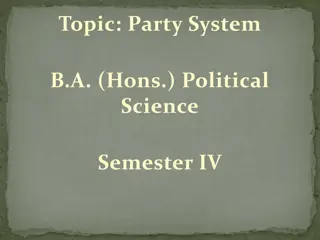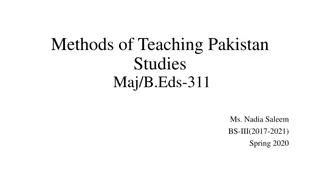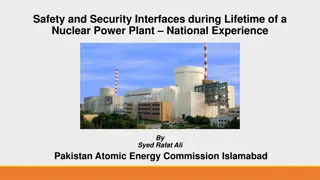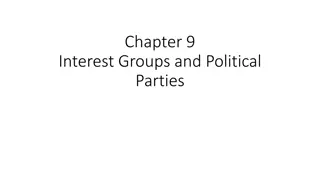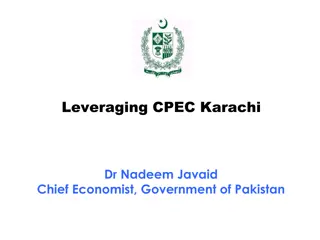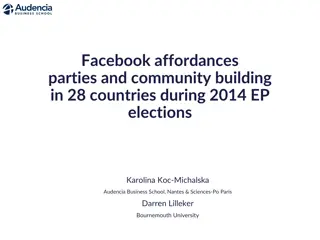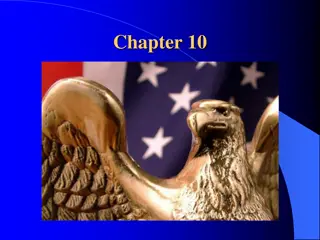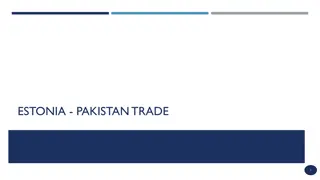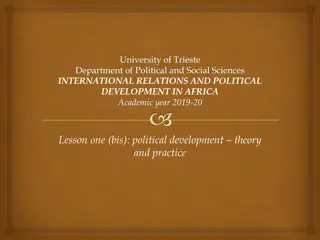Challenges Faced by Political Parties in Pakistan
The history of political parties in Pakistan is marred by complexities intertwined with self-interest and Islamic politics. From the struggle against repressive measures to the evolution of party structures, the landscape of Pakistani politics reflects a unique blend of challenges and opportunities. Explore the historical journey of political parties in Pakistan, their impact on societal development, and the dynamics of power and representation.
Download Presentation

Please find below an Image/Link to download the presentation.
The content on the website is provided AS IS for your information and personal use only. It may not be sold, licensed, or shared on other websites without obtaining consent from the author.If you encounter any issues during the download, it is possible that the publisher has removed the file from their server.
You are allowed to download the files provided on this website for personal or commercial use, subject to the condition that they are used lawfully. All files are the property of their respective owners.
The content on the website is provided AS IS for your information and personal use only. It may not be sold, licensed, or shared on other websites without obtaining consent from the author.
E N D
Presentation Transcript
Lecture 21 HUM111 PAKISTAN STUDIES 1
HUM 111 PAKISTAN STUDIES Lecture The Problems of Political Parties in Pakistan (Part A) Dr. Sohail Ahmad 2
Political Parities in Pakistan Islamic Politics Since Pakistan s inception, the combination of self-interest and Islamic politics has complicated the problem of building a political organization with broad responsibilities to the larger society. Efforts by other parties to contest the power of the League were frustrated and the opposition politicians were often physically prevented from appealing to their constituents and by dubbing them unpatriotic. The League governments used repressive measures against them. The Red Shirt (NWFP), Majlis-i-Ahrar, Jama'at-i-Islami, and the Pakistan National Congress were the targets at different times. 3
Political Parities in Pakistan Pakistani Version of Political Party Ayub bestowed his own constitution to the nation in 1962. Ayub believed that it was possible to conduct government without the formal establishment of political parties but had no recourse other than to resurrect his own political party in the parliament. He borrowed the name of the Muslim League, but when the real Muslim League members displayed their outrage, Ayub modified the name, as Convention Muslim league. It was dissolved on July 5, 1977, when the third martial law was imposed. Again in 1986, Mohammad Khan Junejo recreated it after becoming prime minister in the non-party based elections. 4
Political Parities in Pakistan The growth of political parties within the parliament is a phenomenon confined only to Pakistan. Otherwise, citizens form parties that politically compete for power and if trusted only then enter power corridors of power. Besides the establishment's modus operandi to have obedient political parties in its pocket, personality centered Pakistan People's Party and Awami League were able to articulate people's voice and exhibited unique success in the country's first general elections in 1970 on the basis of adult franchise. However, Z.A Bhutto could not digest the fact that democratically elected leader from the East Pakistan will rule the country. 5
Political Parities in Pakistan Political Parties and Mass Contact The development of political parties is related to the level of development of a society, the quality of mutual relations and the nature of the state structure. The uneven political development in rural and urban areas that affected the growth of parties in the colonial period also persisted, though it gradually narrowed down in 1990s. The trend affected the development of parties in Pakistan. They mostly remained urban-based, with limited contacts with rural population. In the absence of regular elections there was no pressure on the city-based political parties to reach the 70 percent rural population and integrate it in the political process. 6
The Problems of Political Parties [1/6] The Problems of Political Parties Almost all the political parties currently face certain problems. The first is the lack of democracy within the party structure. Second, they are preoccupied with the sole objective of grabbing power. They have failed to encourage the growth of alternate leadership. Third, most of our political parties lack a clear political vision. Corruption has also eaten into the heart of the society, a society that has few resources and great development demands. Thus, they have alienated the citizens from political sharing and participation. 7
The Problems of Political Parties [2/6] Lack of inner democracy All major political parties are accused of democratic malpractices. Their leaders appoint themselves as life chairpersons. Heirs are groomed to take over their father's mantle. Party positions are distributed at a price to favorites. With a few exceptions, political parties in Pakistan have never held elections within their ranks. Often, influential politicians (landlords and industrial barons) sought and secured important positions in major political parties on the basis of nominations. The heads of major political parties are nominated by their so-called working committees or Central Boards, which again comprise non-elected nominated members. 8
The Problems of Political Parties [3/6] Down to the lowest rung of the hierarchical ladder in the party, the leaders of the different tiers and/or Central Executive Committee nominate the office bearers. Consequently, influential people with clout within the party and high command get themselves nominated to important positions in the party. Social and business upstarts with political ambitions employ similar tactics. The heads of the country's two largest political parties often cry hoarse over the need to get rid of military dictatorship, yet they continue the dictatorial practice of nominations in their own parties. Such contradictions hinder the flourishing of normative democratic culture. Consequently, the political parties were hardly prepared to cope with the situation arising out of the assumption of power by General Pervez Musharraf in October 1999. 9
The Problems of Political Parties [4/6] Lack of building up of leaders , the leaders of the two mainstream parties, never encouraged the growth of alternate leadership in their parties. The parties in Pakistan do not build politicians from workers to leaders, from low-ranking to high-ranking public activists and from weak to powerful decision makers, commanding a progressively expanding jurisdictional territory. Hence these parties face a problem in mobilizing their disenchanted workers who seem to be in no mood to make sacrifices for the leadership 10
The Problems of Political Parties [5/6] Corruption and lack of transparency After the October 1999 military coup, many analysts described the two major political parties of Pakistan as corrupt, incompetent, unpopular and highly damaging to the welfare of the people in Pakistan and observed that it was plutocracy ( , ) which was ripping millions of rupees away from the public exchequer. Such charges of corruption against the party leadership further strengthened the feeling of alienation among the people. Political parties funding in Pakistan remains an unanswered question. 11
The Problems of Political Parties [6/6] Political parties and their manifestoes Ritualistically, every party has its manifesto issued at election time but these manifestoes hide a number of contradictions. First, while they consciously try to be all things to all people , they are also high nuance documents. Second, while manifestoes tend to address a long list of problems, they evade prioritizing them - as well as the pledged solutions. They rarely specify how resources, not only financial and economic but political, administrative, cultural and social are to be generated and allocated to mutually competing promises. Fourth, parties are rarely serious enough to sift through and solve even serious contradictions among pledges made in their manifestoes. 12






